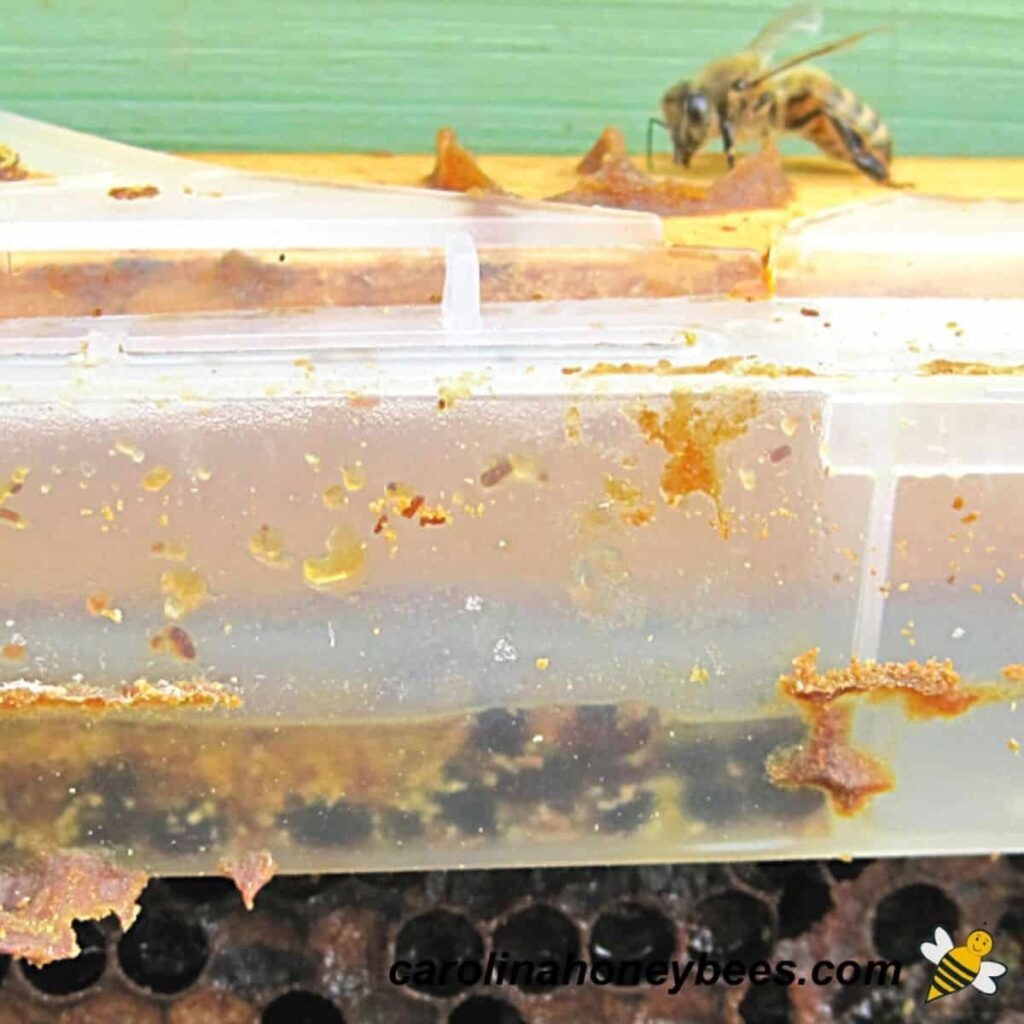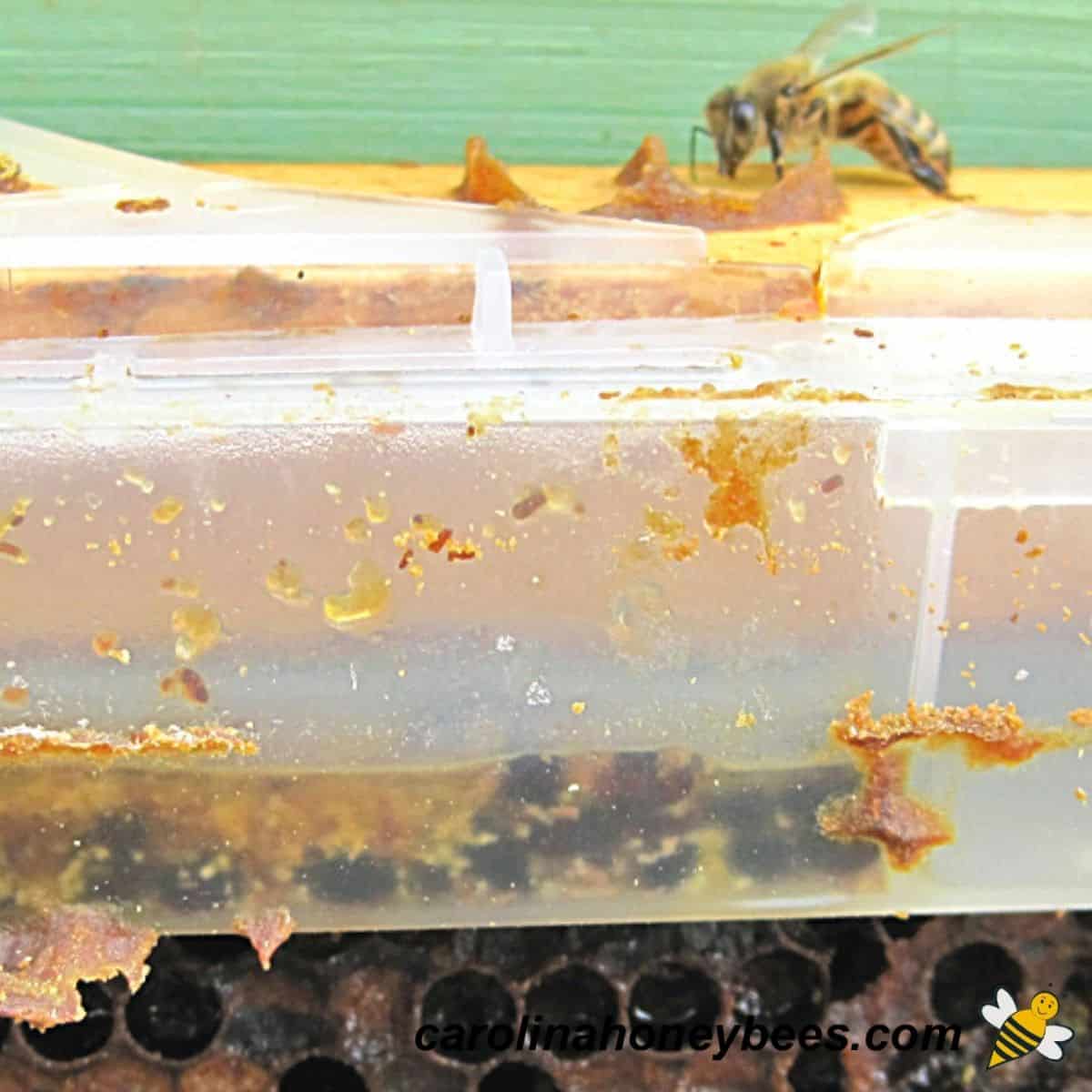The hive beetles are keeping the queen as busy as “a cow’s tail in fly time” (quote source: James Fenimore Cooper) and I’m sorry I haven’t been able to keep up with our records for the Apiary Series at Clark Botanic Garden. If you haven’t noticed, we’ve didn’t post updates for the past two months…and we haven’t taken a group photo, either! We have to fix that!

When she was little, the Queen’s favorite book to practice reading was “Fox In Socks” by Dr. Seuss. She thought beetle battling was funny then.
Do you remember this?
When tweetle beetles fight, it’s called a tweetle beetle battle.
And when they battle in a puddle, it’s a tweetle beetle puddle battle.
AND, when tweetle beetles battle with paddles in a puddle, they call it a tweetle beetle puddle paddle battle.
AND, when beetles battle beetles in a puddle paddle battle and the beetle battle puddle is a puddle in a bottle they call it a tweetle beetle bottle puddle paddle battle muddle.”
It’s not funny anymore. The hive beetles have driven me mad this summer and, as you will see, destroyed some of the hives at Clark Botanic Garden.
How Do The Bees Manage Hive Beetles?
Small hive beetles are invasive pests from Africa. If you remember, I’ve mentioned these little black bugs before. The presence of hive beetles stops bees from doing their other jobs, so I definitely don’t want to see signs of hive beetles anywhere in my hives.

The photo above doesn’t look so bad – but it is. You see a 1:1 ratio of bees to beetles, but that isn’t enough. Additionally, when you see the beetles in the middle of a frame of comb, it’s not good. Bees can’t kill the beetles by stinging them – not only is the beetle shell too hard, the bees would also be killing themselves since they only sting once.
Honeybees set ‘traps’ around the hive, typically on the inner cover. They corral the beetles into build wax “tunnels” and then seal the tunnels up so the beetles can’t come out. If that doesn’t work, they will chase the beetles into a corner and stand guard if they try to leave.
Hive beetles can reproduce very quickly and take over a weak hive. As a beekeeper, my job is to try to identify which hives are weak and do whatever I can to help them get strong enough to fight off a pest like a small hive beetle.
The Beekeeper Battle
There are several ways a beekeeper can TRY to help the hive manage hive beetles, but sometimes the bees don’t like them.
Hive beetle traps, like the one below, can be placed inside the hive. Partially filled with sunflower oil, beetles will fall through the gaps at the top, fall into the oil and drown. It helps a little, but sometimes bees will cover the gaps with beeswax or propolis, making the trap ineffective.

I ask other beekeepers how they manage the beetles and troll the internet for different management techniques that I may have missed. I’ve learned that there IS a pesticide that will kill the hive beetles, but it is also harmful to the bees. Traces of the compound are found in the beeswax and in pollen.
Here is a list from Utah State University Extension that gives some guidelines. In this hot, hot, summer, I’m sure the first two points were taken care of, but maybe that same heat weakened the hives. I have never lost a hive mid-season and this year, I don’t want to tell you the total number!
- Place hives in partial to full sun.
- Keep soil under hives dry to deter SHB pupation.
- Combine, eliminate, or re-queen weak colonies.
- Clean hives and frames, and maintain in good condition to decrease beetle hiding sites.
- Avoid over-supering hives. Having too many boxes gives beetles excessive space to move, hide, and lay eggs.
- Reduce stresses from other bee pests and diseases.
- Keep a high ratio of bees to comb to prevent SHB from hiding from patrolling bees. Similarly, take care when splitting hives to have sufficient numbers of bees present in each split.
When beekeepers extract honey, they have a chance to help the bees by cleaning up the supers. Each super is inspected for gaps and cracks where hive beetles can hide. Frames can be frozen for at least 12 hours to kill the beetle life stages (this is not easy in a home freezer). The wax cappings should be processed immediately as well.
Looking Forward: How to prevent weak hives
As this year winds down and I run from yard to yard trying to help the bees, I’m thinking about what needs to be done for next year to prevent a similar situation. I need to take some responsibility for the way I managed the hives and figure out a plan to improve.

Bees are really hardworking, but how will I make their job easier next year? There are two things I can do:
- I need to start at the beginning of the season. So next spring, I will be extra careful with the number of supers I add to a hive. We had a lot of temperature fluctuations this year and I couldn’t keep up with adding and taking away supers. I may have added to their stress by giving them too much, too soon.
- Feed the bees at the beginning of the season. For humans, “the most important meal of the day is breakfast” (or so my mother said). For bees, they forage all day, but again…spring was especially hard and bloom times were off. So to manage the bees health via nutrition, I will do two things:
- Plant more spring blooming bulbs. Crocuses, drumstick allium, and grape hyacinth are a few nutrition power-houses for pollinators in the springtime. Bulbs emerge before the trees blossom (and before dandelions), making them a invaluable source of early season nectar and pollen for the bees. Many gardeners skip the bulbs and go right to pansies and/or impatiens, neither of which the bees appreciate.
- There are several ways to feed bees, but they all take time, equipment, and more time! While working on a biodynamic farm, I learned a recipe for a “bee tea” made with honey, white sugar, water, and herbs like chamomile, thyme, and mint. When I feed the bees this mixture, it just feels so ‘right’! I’m gonna work on drying my herbs this fall and bee ready to treat the bees in the spring.

July Observations
Our visit to the apiary was HOT! We didn’t have as many people, but I also forgot to send out a reminder in advance. Was it the heat, or lack of reminder?
It is important to look back over records to see trends. Sadly, the total number of hives is changing from month to month at Clark Botanic Garden.
| TOTAL # HIVES | 11 |
| Presumed dead: hives with no activity, no bees entering in or out | 1 |
| Weather on day of class | 84 degrees F, humid, partially cloudy |
| Number of participants | 15 |
| Plants in Bloom | Anise hyssop, bee balm, spirea |
Controversial Thank You Surprises
This month’s surprise was surprisingly controversial…in a good way, of course. The prize was a bag of organic produce from Golden Earthworm Farm (extras from my CSA). The winner was the first to guess the “vegetable” I was thinking of…a pumpkin.

Did I cheat when I used a pumpkin? Well…to bee honest, once we started the game, it DID cross my mind that a pumpkin wasn’t exactly on everyone’s vegetable list, but the game had begun…what could I do?
After our talk, I received more than one e-mail instructing me on the proper classification of pumpkins. Pumpkins are fruits…not vegetables. I’m sorry!
You Can Help
Do you have early spring blooms in your garden? It’s time to plant spring blooming bulbs NOW. Backyard Bees is hosting a fundraiser for the Clark Botanic Garden Auxiliary that will help you get the best bulbs to bring early spring color to your yard, AND help the bees! Please check out the sale and/or consider making a donation.
Bee In Touch
Our next meeting is on August 29th and it’s almost here already!
We’ll send you a reminder e-mail and you can message us if you have any outstanding questions. You can also follow Backyard Bees over on our Facebook page or Instagram account.
If you’d like to support the Backyard Bees Apiary, we welcome donations for purchase of supplies. We are specifically working towards an observation hive which costs approximately $300, but our first priority is making sure we have live bees in all the hives – a new colony of bees costs $200, and any little bit helps!
BEE WELL! See you soon for the August Apiary! xoxo The Queen Bee!



